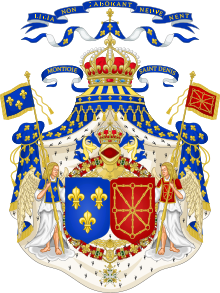You can help expand this article with text translated from the corresponding article in French. (June 2021) Click for important translation instructions.
|

Montjoie Saint Denis! (French pronunciation: [mɔ̃tʒwa sɛ̃ dəni]) was the battle-cry and motto of the Kingdom of France. It allegedly refers to Charlemagne's legendary banner, the Oriflamme, which was also known as the "Montjoie" and was kept at the Abbey of Saint Denis, though alternative explanations exist. The battle-cry was first known to be used during the 12th century reign of Louis VI of France, the first royal bearer of the Oriflamme.
Etymological theories
Whilst "Saint Denis" undoubtedly refers to the ancient Saint Denis of Paris, the etymology of the term "Montjoie" is overall uncertain. It is first attested in The Song of Roland (12th century). The Catholic Encyclopedia suggested it originated in a term for marking stones or cairns set up on the roadside – in Late Latin known as mons Jovis – which from c. 1200 in French appears as monjoie. According to the Encyclopedia, cairns were used by warriors as gathering places, and the term was applied to the Oriflamme by the analogy that it was a place warriors gathered for combat. "Montjoie" has also been proposed as being derived from a Common Germanic phrase, *mund gawi ("pile of stones"), supposedly used as a battle cry in a sense like "hold the line!". It has alternatively been proposed as deriving from *mund galga, from mund ("protect") and galga ("cross, rood") (as pilgrims would often affix crucifixes to these stones). Charles Arnould claimed the word originated in Gaulish *mant- ("path") and *gauda ("pile of stones").
Additional etymological theories exist which do not connect the term "montjoie" to the traditional explanation of the Oriflamme. Henri Diament believed it was in reference of the martyrdom of Saint Denis of Paris, which he claimed was associated with a Mons Jovis or Mons Gaudii ("Mountain of Joy"). However this connection is unexplained, as the name of the place of St. Denis' martyrdom, Montmartre, originated from Mons Martis rather than Mons Jovis. A connection to Montmartre is re-affirmed by G. Bugler, who believed the "joie" came from a cognate of "Gau", or region, presumably translating the phrase as "the place of the hill of St. Denis". Laura Hibbard Loomis believed the phrase to have originated from "meum gaudium" (my joy). This alternative Latin etymology is given by Gerhard Rohlfs, who connected it to "Mons Gaudii", a name given by medieval pilgrims to a point where one would get their first glimpse of their destination.
Contemporary usage
The term has been sometimes associated with the royalist right-wing in France. In June 2021, French president Emmanuel Macron was slapped in the face by a man who shouted the motto. French legislator Éric Coquerel claimed that the perpetrators of a 2018 pie attack against him, associated with Action Française, had also used the phrase.
The term was used by Georges Bataille and the Acephale when congregating in the woods of Paris. This was not based in pious or monarchical motivations that it may have been in the Middle Ages. Instead Bataille championed another, more archaic and impious version that was personified by Gilles de Rais who according to Bataille was the very incarnation of the feudal principle of expenditure.
Notes
- Also known in minor variants such as Montjoye-Saint-Denis, and in French often written emphasizing its exclamation as "Montjoie ! Saint Denis !".
- The asterisk * used throughout signifies the standard symbol of terms created by linguistic reconstruction.
References
- ^ Larousse, Éditions. "Définitions: montjoie - Dictionnaire de français Larousse". www.larousse.fr.
- ^ Goyau, G. (1911). "CATHOLIC ENCYCLOPEDIA: Oriflamme". www.newadvent.org. New York: Robert Appleton Company. Retrieved January 2, 2018.
- ^ Duggan, Joseph J. (June 9, 1976). A Guide to Studies on the Chanson de Roland. DS Brewer. p. 53-. ISBN 9780729300179 – via Google Books.
- Saint-Allais 1816: Ce qu'on a de plus sensé sur cette matière se réduit à remarquer qu'on appelait autrefois Mont-Joye un monceau de pierres entassées pour marquer les chemins ; sur quoi le Cardinal Huguet de Saint-Cher rapporte la coutume des pèlerins, qui faisaient des Mont-Joyes de monceaux de pierres sur lesquels ils plantaient des croix aussitôt qu'ils découvraient le lieu de dévotion où ils allaient en pèlerinage Or, comme ces Mont-Joyes étaient destinés à marquer les chemins, de même, quand nos rois eurent pris Saint-Denis pour protecteur du royaume, et sa bannière ou l'oriflamme pour bannière de dévotion dans les armées, cette bannière devint le Mont-Joye qui réglait la marche de l'armée Il est bon aussi d'observer que ce cri de guerre n'a été introduit dans nos armées que vers le règne de Louis-le-Gros, qui, ayant réuni en sa personne le comté de Vexin à la couronne, devint avoué de l'église de Saint-Denis, en prit la bannière, de laquelle est venu le cri d'armes.
- "Emmanuel Macron giflé : à quoi fait référence "Montjoie Saint Denis", slogan crié par l'agresseur ?" [Emmanuel Macron slapped: what does "Montjoie Saint Denis" refer to, a slogan shouted by the aggressor?]. La Chaîne Info (in French). 8 June 2021.
Further reading
- Millington, Ellen J. (1858). Heraldry in history, poetry, and romance. p. 58.
- Foley, Michael P. (4 May 2015). Drinking with the Saints: The Sinner's Guide to a Holy Happy Hour. Simon and Schuster. p. 355. ISBN 978-1-62157-383-8.
- Wilson, Stephen (1985). Saints and Their Cults: Studies in Religious Sociology, Folklore and History. CUP Archive. p. 153. ISBN 978-0-521-31181-6.
Categories: